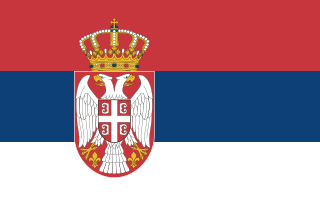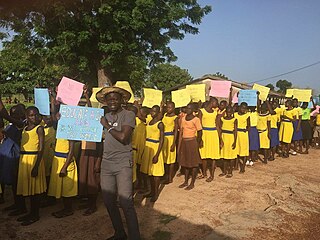Gifted education is a sort of education used for children who have been identified as gifted and talented.
Special education is the practice of educating students in a way that accommodates their individual differences, disabilities, and special needs. This involves the individually planned and systematically monitored arrangement of teaching procedures, adapted equipment and materials, and accessible settings. These interventions are designed to help individuals with special needs achieve a higher level of personal self-sufficiency and success in school and in their community, which may not be available if the student were only given access to a typical classroom education.
Cooperative education is a structured method of combining classroom-based education with practical work experience.
The Education Quality and Accountability Office (EQAO) is a Crown agency of the Government of Ontario in Canada. It was legislated into creation in 1996 in response to recommendations made by the Royal Commission on Learning in February 1995.
An Individualized Education Program (IEP) is a legal document under United States law that is developed for each public school child in the U.S. who needs special education. It is created through a team of the child's parent(s) and district personnel who are knowledgeable about the child's needs. IEPs must be reviewed every year to keep track of the child's educational progress.
Prescott College is a private college in Prescott, Arizona.
A lesson plan is a teacher's detailed description of the course of instruction or "learning trajectory" for a lesson. A daily lesson plan is developed by a teacher to guide class learning. Details will vary depending on the preference of the teacher, subject being covered, and the needs of the students. There may be requirements mandated by the school system regarding the plan. A lesson plan is the teacher's guide for running a particular lesson, and it includes the goal, how the goal will be reached and a way of measuring how well the goal was reached.

Education in Serbia is divided into preschool (predškolsko), primary school, secondary school and higher education levels. It is regulated by the Ministry of Education, Science and Technological Development of the Republic of Serbia.

Inclusion in education refers to all students being able to access and gain equal opportunities to education and learning. It arose in the context of special education with an individualized education program or 504 plan, and is built on the notion that it is more effective for students with special needs to have the said mixed experience for them to be more successful in social interactions leading to further success in life. The philosophy behind the implementation of the inclusion model does not prioritize, but still provides for the utilization of special classrooms and special schools for the education of students with disabilities. Inclusive education models are brought into force by educational administrators with the intention of moving away from seclusion models of special education to the fullest extent practical, the idea being that it is to the social benefit of general education students and special education students alike, with the more able students serving as peer models and those less able serving as motivation for general education students to learn empathy.
Special education in the United States enables students with exceptional learning needs to access resources through special education programs. These programs did not always exist. "The idea of excluding students with any disability from public school education can be traced back to 1893, when the Massachusetts Supreme Court expelled a student merely due to poor academic ability". This exclusion would be the basis of education for all individuals with special needs for years to come. In 1954, Brown v. Board of Education sparked the belief that the right to a public education applies to all individuals regardless of race, gender, or disability. Finally, special education programs in the United States were made mandatory in 1975 when the United States Congress passed the Education for All Handicapped Children Act (EAHCA) "(sometimes referred to using the acronyms EAHCA or EHA, or Public Law 94-142) was enacted by the United States Congress in 1975, in response to discriminatory treatment by public educational agencies against students with disabilities." The EAHCA was later modified to strengthen protections to students with disabilities and renamed the Individuals with Disabilities Education Act (IDEA). IDEA requires states to provide special education and related services consistent with federal standards as a condition of receiving federal funds.

Tracking is separating students by academic ability into groups for all subjects or certain classes and curriculum within a school. It may be referred to as streaming or phasing in some schools.

Education in Ethiopia was dominated by the Ethiopian Orthodox Church for many centuries until secular education was adopted in the early 1900s. Prior to 1974, Ethiopia had an estimated literacy rate below 50% and compared poorly with the rest of even Africa in the provision of schools and universities. After the Ethiopian Revolution, emphasis was placed on increasing literacy in rural areas. Practical subjects were stressed, as was the teaching of socialism. By 2015, the literacy rate had increased to 49.1%, still poor compared to most of the rest of Africa.
Education in Croatia is a right defended by Article 66 of the Constitution which states that everyone is entitled to free compulsory education under equal conditions and in accordance with their aptitudes. Education is mandatory for children aged 6 to 14.
The jigsaw technique is a method of organizing classroom activity that makes students dependent on each other to succeed. It breaks classes into groups that each assemble a piece of an assignment and synthesize their work when finished. It was designed by social psychologist Elliot Aronson to help weaken racial cliques in forcibly integrated schools. A study by John Hattie found that the jigsaw method benefits students' learning.
Whitby School is an independent, co-educational private school in Greenwich, Connecticut, that was founded in 1958 and is accredited by the American Montessori Society, the International Baccalaureate Organization, and the Connecticut Association of Independent Schools. The Head of School is Dr. John "Jack" Creeden, who joined Whitby in July 2019.

Manhattan Village Academy (MVA) is a small, public high school located in the Flatiron District, New York City. It consists of grades 9–12 with an enrollment of 461 students. The school is part of the New York City Department of Education. The school was founded by veteran educator Mary Butz in 1993. The administration is currently headed by principal Christina White.
Multi-age classrooms or composite classes are classrooms with students from more than one grade level. They are created because of a pedagogical choice of a school or school district. They are different from split classes which are formed when there are too many students for one class – but not enough to form two classes of the same grade level. Composite classes are more common in smaller schools; an extreme form is the one-room school.

NOVA International School Skopje is an independent, university-preparatory, coeducational, day school that offers an educational program from pre-kindergarten (three-year-olds) through grade 12.

In the United States, elementary schools are the main point of delivery of primary education, for children between the ages of 4–11 and coming between pre-kindergarten and secondary education.

K-12 education in the United States includes primary education starting in kindergarten, and secondary education ending in grade 12. Government-funded free schools are generally provided for these grades, but private schools and homeschooling are also possible. Most children begin elementary education with kindergarten and finish secondary education with twelfth grade. In some cases, pupils may be promoted beyond the next regular grade. Parents may also choose to educate their own children at home; 1.7% of children are educated in this manner.







